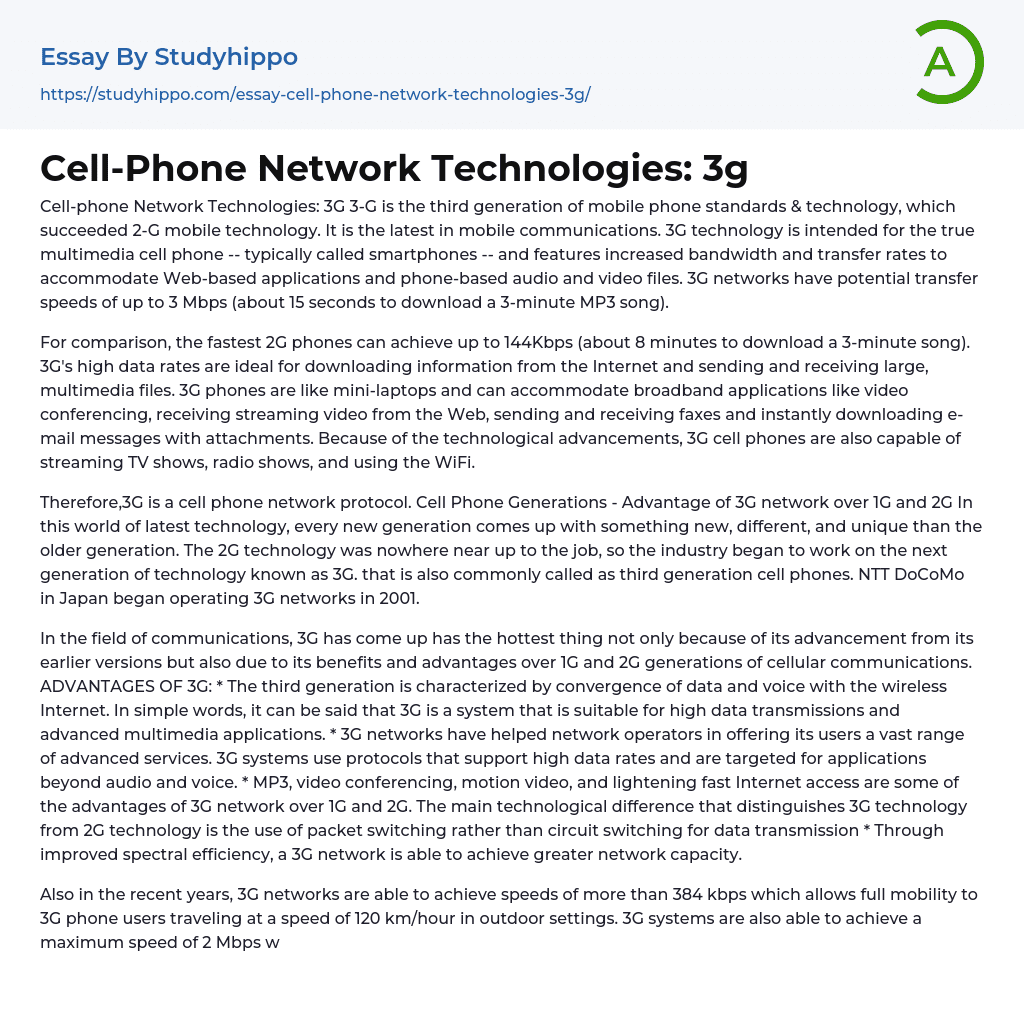Cell-phone Network Technologies: 3G 3-G is the third generation of mobile phone standards & technology, which succeeded 2-G mobile technology. It is the latest in mobile communications. 3G technology is designed for the true multimedia cell phone, commonly known as smartphones, and has higher bandwidth and transfer rates to support web-based applications and phone-based audio and video files. 3G networks can achieve potential transfer speeds of up to 3 Mbps (approximately 15 seconds to download a 3-minute MP3 song).
The speed of the fastest 2G phones can reach up to 144Kbps, which is about 8 minutes for downloading a 3-minute song. On the other hand, 3G phones have high data rates that are perfect for downloading Internet content and sending/receiving large multimedia files. Similar to mini-laptops, these phones can handle broadband applications like video conferencing, streaming web vid
...eos, faxing, and instant email downloads with attachments. Thanks to advancements in technology, 3G cell phones can also stream TV shows and radio shows while using WiFi. Therefore, in this ever-evolving world of technology, the speed and functionality advantages offered by the 3G network protocol surpass those of both 1G and 2G networks.
The industry started developing 3G, also referred to as third generation cell phones, as an improvement to the inadequate 2G technology. In 2001, NTT DoCoMo in Japan launched 3G networks. The popularity of 3G in the communications field originates from its advancements over earlier versions and the benefits it offers compared to 1G and 2G cellular communications.
ADVANTAGES OF 3G: * The third generation brings together data, voice, and wireless internet. Simply put, it is a system made for high data transmission and advanced multimedia applications. * Networ
operators benefit from 3G networks as they can provide their users with various advanced services. The protocols used in 3G systems support high data rates and are intended for applications beyond audio and voice. * 3G networks offer advantages like MP3 capabilities, video conferencing, motion video, and exceptionally fast internet access when compared to 1G and 2G networks.
The primary distinction between 3G technology and 2G technology is the utilization of packet switching for data transmission instead of circuit switching. This transition has enabled 3G networks to achieve a higher network capacity and improved spectral efficiency. In recent years, 3G networks have been capable of delivering speeds exceeding 384 kbps, enabling full mobility for users traveling at speeds up to 120 km/hour outdoors. Furthermore, 3G systems can reach a maximum speed of 2 Mbps, allowing users with limited mobility to experience speeds below 10 miles per hour in short-range indoor or stationary environments. Some services offered by 3G encompass video calls, broadband wireless, and wide area voice telephony—all accessible in a mobile environment.
Transfer of voice data (a telephone call) and non-voice data (downloading, email, instant messaging). For example, the Nokia E75 is equipped with 3G technology for improved media transmission and numerous advanced features. However, there are disadvantages associated with 3G. These include complaints about the high cost of 3G phones, limited network coverage due to it being a new service, and the high power consumption of 3G phones.
- Networking essays
- Telecommunication essays
- Network Topology essays
- Telecommunications essays
- Email essays
- Hypertext Transfer Protocol essays
- Marshall Mcluhan essays
- Virtual Learning Environment essays
- Web Search essays
- Etiquette essays
- Mainstream essays
- Vodafone essays
- Web Search Engine essays
- 3g essays
- Bluetooth essays
- Mobile Phones essays
- Android essays
- Application Software essays
- Benchmark essays
- Computer Network essays
- Computer Programming essays
- Computer Security essays
- Computer Software essays
- Cryptography essays
- Data collection essays
- Data Mining essays
- Graphic Design essays
- Information Systems essays
- Internet essays
- Network Security essays
- Website essays
- World Wide Web essays




